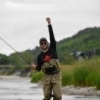Search the Community
Showing results for tags 'alberta'.
-
A few weeks ago I was floating the Elk River in Fernie with my dad's buddy who has been a guide on the Bow, and the river systems around the Fernie area for the last 30+ years. We had 2 of the best days we've ever had dry fly fishing on the Elk and easily one of the best dry fly days of my life. Period. At one point during the day we got to chatting about the CW licensing system in BC and how difficult - and somewhat expensive it is - for an AB angler to get unguided days on the Elk and some of the other incredible smaller water systems in the area. I mentioned how I felt that some AB river systems had changed so much over the years with crowds, campers etc. and how much the fish populations & over-all health of the fish/river had changed as well. Not all for the better. I feel BC's CW licensing system has a great deal to do with how well the Kootenay river systems are managed & that AB could benefit from something similar to make sure our trout fisheries stay in good shape for future generations. So my first question is this; what are the pros/cons of a CW licensing system in AB? We continued to chat about this topic as we floated the Elk that day and got to chatting about the benefits of a 'ski-pass' like CW licensing system for rivers in the Kootenay zone - i.e. pay $250 and get a seasons pass to the Elk, Michel & Alexander Creek for example, or for a longer period of time, say 5-10+ days. We both agreed it would be best if it was a fly fishing only licensing system, that it was likely to increase traffic on the more popular systems, but could be set up with close support from outfitters and guides in the area to make sure it worked for all of those who rely on those river systems to make a living. This leads me to my second question; what are the pros/cons of this 'ski-pass' like licensing system? Very interested to hear the communities thoughts! RW
- 8 replies
-
- 1
-

-
- livingstone river
- bowriver
- (and 7 more)
-
There are a lot of nervous folks here in Calgary as we edge closer to flood season. As someone who lived in a community adjacent to the river, I will never forget what happened in June of 2013. The NDP have committed to nearly $297M in flood mitigation projects on the Elbow River. The linchpin of Elbow River flood mitigation will be the Springbank Dry Dam: https://www.youtube.com/watch?v=hp5Rut8CrmU. To date, shovels have not gone into the ground, and Calgary is no safer from floods today than it was in 2013. Calgary Herald, Don Braid: No flood projects yet, so pass the sandbags Here's the main problem: instead of addressing the cause, we are responding to the effects. Deterioration of riprarian areas in Eastern Slopes headwaters plays a very big role when it comes to flooding. Fens and other natural vegetation act as a natural sponge and can mitigate the impacts of flooding further downstream. Without a natural buffer in place, flood waters race out of the mountains and into the prairies at a torrid pace. Imagine what a $297M investment in our headwaters could accomplish with natural solutions to flood mitigation/prevention? I think it's time for a new approach.
-
There have been a lot of conversations about OHV use this week. There have been some great conversations on this forum and in various social media spaces (some of the dialouge on FaceBook spaces like The Crowsnest Journal and Alberta Fly Fishing have been particularly interesting. Check out the latest blog post from the Oldman Watershed Council: http://oldmanwatershed.ca/blog-posts/2016/1/28/ohvs-and-the-owc-where-do-we-stand For the OWC the bottom line is watershed health, so hearing their perspective is especially interesting.
-
Apologies to anyone who had already read this, it somehow got itself removed from the forum. http://pikepinksterab.blogspot.ca/2015/07/a-load-of-bull.html There was something I wanted to add to the content in the blog for discussion: We hear that increased recreational and industrial pressure is causing huge amounts of sediment and silt to enter the rivers. This sediment is hardening and putting a concerete like layer over bull trout spawning grounds. Is there anything that could be done to remove those layers of silt? I'm not talking about having come in with a jack hammer and blast that junk off...but I suspect there could be some remedial actions that could reopen some of these waters to spawning.
- 4 replies
-
- 1
-

-
- bull trout
- Alberta
-
(and 1 more)
Tagged with:
-
After a month away, I decided to awaken from hibernation and post my latest blog. It's bear season! http://pikepinksterab.blogspot.ca/2015/05/the-bear-necessities.html


